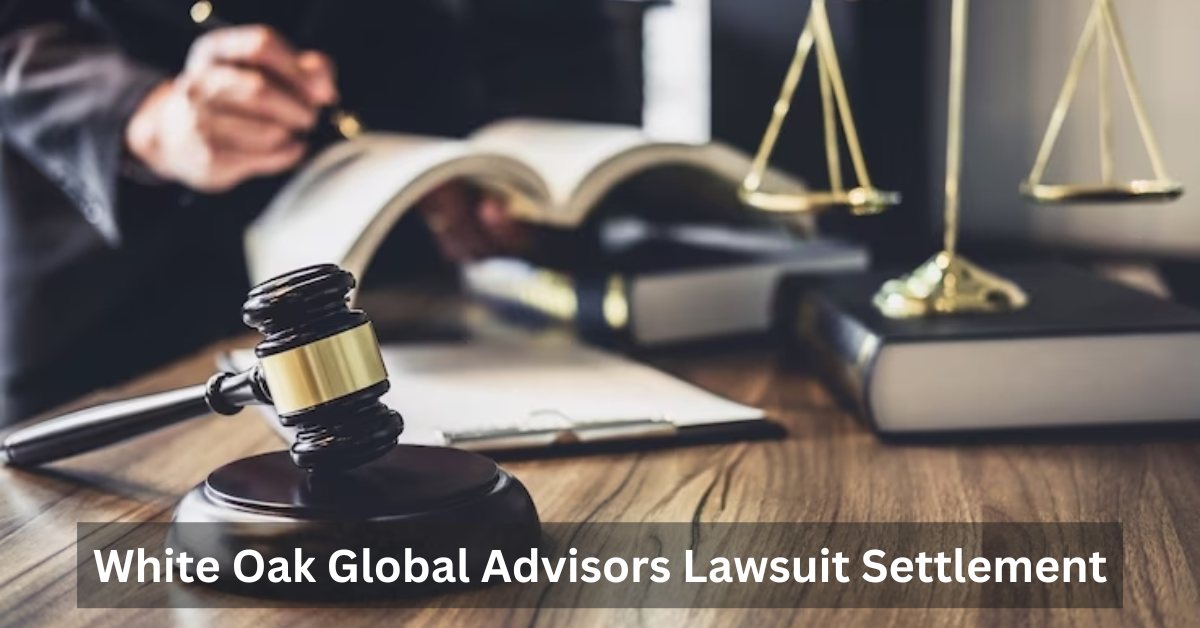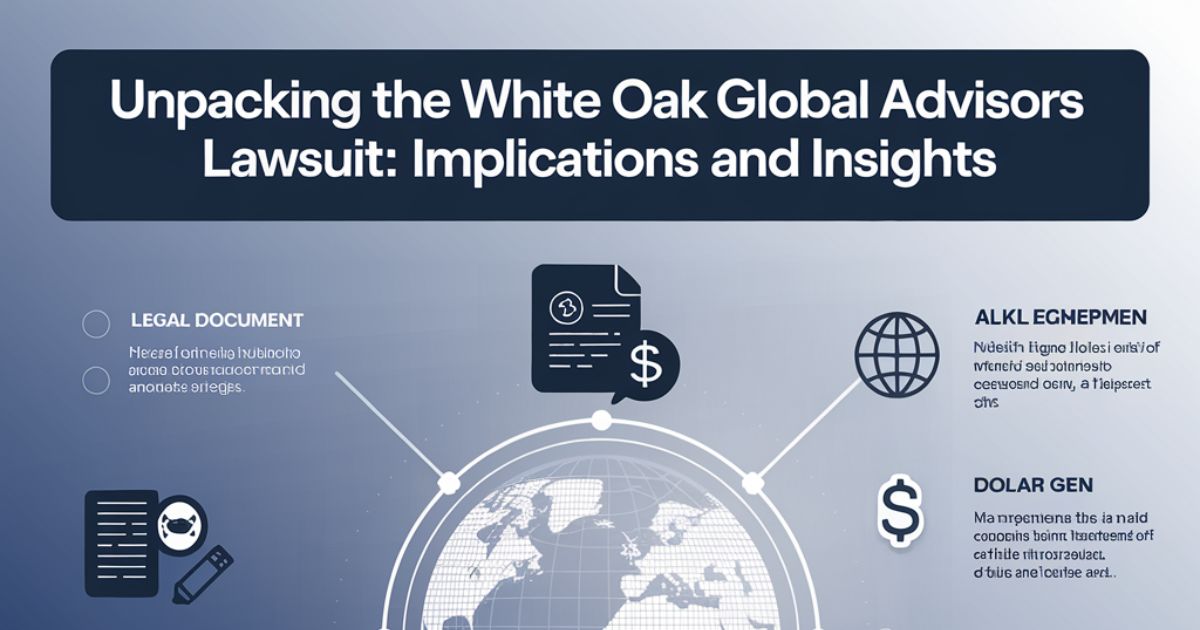Introduction to the White Oak Global Advisors Lawsuit
The lawsuit involving White Oak Global Advisors has garnered significant attention within the financial and investment sectors. As a prominent investment management firm, White Oak Global Advisors is recognized for its strategic investment approach and portfolio management services. The legal matter arises from a dispute between White Oak and a former partner, which centers around allegations of breach of contract and fiduciary duty. This case highlights the complexities inherent in partnership agreements within the finance industry.
The parties involved in this lawsuit are White Oak Global Advisors, known for its focus on private equity and credit investments, and the former partner who claims that White Oak failed to uphold specific contractual obligations. The former partner asserts that the firm engaged in practices that not only violated their partnership agreement but also caused significant financial harm. Such allegations are particularly alarming given the high stakes involved; reputational damage and financial losses for both parties can have widespread implications beyond the immediate dispute.
The stakes extend beyond just the parties directly involved. For White Oak Global Advisors, the outcome of this lawsuit could affect its business operations, client relationships, and market standing. Investors and stakeholders will be closely monitoring the proceedings, as the lawsuit may set precedents that influence contract enforcement and fiduciary responsibilities within investment firms. Additionally, the case could prompt firms within the industry to reevaluate their internal policies and partnership agreements to mitigate potential legal risks.
Overall, understanding the intricacies of the White Oak Global Advisors Lawsuit is critical for industry professionals and investors alike. The case serves as a reminder of the importance of clear agreements and ethical practices within financial partnerships, underscoring the potential for significant repercussions when these principles are disregarded.
Background of White Oak Global Advisors

Founded in 2007, White Oak Global Advisors has established itself as a prominent player in the investment management industry. With a focus on credit-oriented strategies, the firm primarily serves institutional investors, including pension funds, endowments, and foundations. White Oak is known for its disciplined investment approach, which combines fundamental analysis with a deep understanding of market dynamics.
White Oak’s leadership team comprises seasoned professionals with extensive experience in finance and investment. Notably, the firm was co-founded by Andrew O. B. Dubin, who has been influential in shaping its strategic direction. Under Dubin’s stewardship, White Oak has implemented rigorous investment processes, emphasizing risk management, transparency, and a commitment to delivering value to its clients. The depth of expertise within the company extends to various sectors, enabling them to navigate complex financial landscapes effectively.
One of the core strategies employed by White Oak Global Advisors is direct lending, a practice that has gained popularity in the post-financial crisis era. The firm strives to identify attractive opportunities in the private credit market, offering customized financing solutions to mid-sized companies. This direct lending approach aligns with their goal to provide stable and attractive returns in a low-interest-rate environment, catering to clients who seek diversification and yield in their portfolios.
Over time, White Oak has broadened its investment strategies by adapting to market trends and clients’ evolving needs. This includes exploring investment opportunities in real estate, structured credit, and other alternative assets. Their commitment to innovation and strategic growth has positioned them as a key player in the investment landscape, drawing the attention of investors and stakeholders alike.
However, this dynamic growth trajectory has recently been overshadowed by legal challenges, underscoring the complexities involved in the investment management industry. Understanding the history and operations of White Oak Global Advisors provides valuable context for analyzing the ongoing lawsuit and its implications for the firm and its clients.
Details of the Lawsuit

The lawsuit against White Oak Global Advisors has garnered significant attention due to the serious allegations made regarding its investment practices. The case emerged when several former clients filed a complaint claiming that the firm had engaged in misleading promotional activities, which included overstating its investment performance. These allegations were predicated on the assertion that White Oak Global Advisors misrepresented its historical returns to prospective investors, suggesting a level of performance that did not accurately reflect the firm’s actual investment outcomes.
In addition to concerns about misleading marketing practices, the complainants have also raised issues related to breaches of fiduciary duties. This legal claim alleges that White Oak Global Advisors placed its interests ahead of those of its clients, thereby failing to act in their best financial interests. Such breaches are critical as they challenge the trust foundational to client-advisor relationships in the financial industry.
The evidence presented in the lawsuit includes internal emails and marketing materials that ostensibly reveal discrepancies between the firm’s actual performance and the figures promoted to potential investors. The plaintiffs argue that this misrepresentation not only led to financial losses for clients but also violated various industry regulations designed to protect investors. In response, White Oak Global Advisors has denied all allegations, asserting that its investment strategies and communications with clients were compliant with regulatory standards.
As the case unfolds, it raises pertinent questions about the practices of investment advisory firms and the importance of transparency in client communications. The outcome of this lawsuit could have wider implications for the advisory industry, potentially influencing regulations and best practices moving forward. The situation warrants close observation, shedding light on the responsibilities of investment firms in maintaining ethical standards and upholding their fiduciary duties to clients.
Responses from White Oak Global Advisors

In light of the ongoing lawsuit, White Oak Global Advisors has provided several official statements that shed light on their perspective regarding the situation. The company maintains that the claims brought against them are without merit and asserts their commitment to defending their business practices vigorously. White Oak has described the allegations as unfounded and has expressed confidence in the resilience of their strategic foundations and operational integrity.
Legal strategy plays a central role in White Oak’s approach to addressing the lawsuit. The firm has engaged a team of seasoned legal professionals with expertise in navigating complex financial regulatory environments. Their attorneys have publicly indicated that they will seek to dismiss the lawsuit at the earliest opportunity, arguing that the claims lack factual and legal substantiation. This proactive stance is indicative of White Oak’s commitment to protecting its reputation and ensuring that its operational model remains intact amidst legal scrutiny.
In addition to any formal legal maneuvers, White Oak Global Advisors has also issued public statements aimed at their clients, stakeholders, and the broader financial community. These communications emphasize the firm’s long-standing dedication to transparency and ethical investment practices. They highlight the importance of maintaining trust with their investors while navigating the challenging landscape posed by the allegations. Furthermore, White Oak is poised to address any counterclaims that may arise, showcasing their readiness to engage comprehensively in the legal process.
Ultimately, White Oak Global Advisors seeks to clarify their position and reassure all parties involved of their robust defense strategy. Their responses reflect a determined effort to contest the lawsuit while continuing to uphold the values and standards that define their business operations.
Reactions from the Financial Community

The lawsuit involving White Oak Global Advisors has elicited a range of reactions from financial analysts, investors, and stakeholders within the financial community. The initial response was marked by a sense of concern and curiosity about the implications of the lawsuit for both the firm and the broader financial sector. Many analysts noted that the allegations could potentially undermine investor confidence, especially if they perceive ethical breaches or regulatory non-compliance. Such sentiments were echoed by various investment firms that closely monitor the activities of key players in the asset management industry.
Investors have also expressed mixed reactions. Some expressed apprehension regarding their current investments in White Oak Global Advisors, fearing that the lawsuit might lead to significant financial repercussions or reputational damage. Others viewed the situation as a potential buying opportunity, believing that the legal proceedings might ultimately lead to corrective measures within the firm that could restore its standing in the market. This divergence of opinion illustrates the complex nature of investor sentiment in the face of legal challenges.
Furthermore, the financial media has actively covered the unfolding developments, drawing attention to both the positive and negative aspects of the situation. Articles often highlight the importance of governance and regulatory compliance in asset management. Analysts are keenly watching the case’s progression, emphasizing its potential impact on legislation and compliance standards across the financial landscape. There is a general consensus that the outcome could lead to heightened scrutiny of investment firms, prompting increased regulatory measures aimed at safeguarding investor interests and maintaining market integrity.
As these reactions continue to materialize, the financial community remains on alert, recognizing that such lawsuits can reshape the dynamics of trust and accountability in the industry.
Legal Implications of the Case

The ongoing lawsuit involving White Oak Global Advisors presents significant legal implications that resonate within the financial sector. As this case unfolds, it provides a valuable lens through which to view the evolving landscape of financial regulations and the responsibilities incumbent upon financial advisory firms. This lawsuit has the potential to set a critical precedent concerning the fiduciary duties and ethical obligations of financial advisors.
One of the most pertinent aspects of the White Oak case is its emphasis on compliance with regulatory standards. In recent years, there has been a growing scrutiny of financial institutions’ practices, particularly regarding transparency and accountability. The outcome of this lawsuit may influence future compliance requirements for financial advisors, guiding them to adopt more stringent measures to avoid liability. These shifting standards underscore the importance of maintaining robust internal controls and transparent client communication, which are essential for mitigating risks associated with litigation.
Moreover, the White Oak Global Advisors Lawsuit illustrates potential repercussions for financial professionals who may overlook their legal obligations to clients. Should the court rule against the firm, it could pave the way for increased claims against financial advisors who fail to adhere to these vital regulations. This outcome might encourage whistleblower protections and better reporting practices in the industry, as professionals seek to safeguard not just their interests but also the interests of those they serve.
As so many sectors are already leaning towards greater accountability, the ramifications of the White Oak lawsuit may extend beyond just this case. Financial advisors and firms will need to scrutinize their practices continuously to ensure compliance with both existing and emerging regulations. This evolving legal landscape will undoubtedly shape the way financial services operate and respond to client needs in the years to come.
Potential Consequences for White Oak Global Advisors

The lawsuit involving White Oak Global Advisors presents various potential consequences that could significantly impact the firm’s operations and reputation. Firstly, if the legal proceedings result in a judgment against the company, it may face substantial financial repercussions. These could manifest in the form of hefty fines or settlement payments, therefore straining the firm’s financial resources. Such financial setbacks could influence its ability to invest in new ventures or maintain liquidity, potentially affecting stakeholders and investors.
Furthermore, the lawsuit may necessitate changes to White Oak’s operational strategies. To mitigate future risks and enhance compliance, the firm could implement enhanced training for its employees regarding regulatory standards and ethical conduct. These operational adjustments could result in short-term disruptions but, in the long run, may foster a culture of diligence and transparency, ultimately improving the firm’s sustainability.
Another critical aspect of this lawsuit is its potential impact on White Oak’s reputation within the financial sector. The perception of a legal dispute may lead to reduced trust among clients, partners, and investors. Negative media coverage surrounding the lawsuit could amplify this effect, potentially causing existing and prospective clients to reconsider their associations with the firm. Addressing reputational harm may require White Oak to engage in public relations efforts, clarifying its stance and demonstrating its commitment to rectitude within the industry.
On a more optimistic note, if White Oak Global Advisors effectively navigates the lawsuit, it could emerge with strengthened practices and a clearer operational framework. Such resilience may enhance the firm’s reputation for integrity and compliance, ultimately attracting a more discerning client base. Therefore, the consequences of the lawsuit are multifaceted, with the potential to reshape White Oak’s landscape in various dimensions.
What This Means for Investors

The ongoing lawsuit involving White Oak Global Advisors presents a complex landscape for both current and prospective investors. One of the most pressing implications is the potential volatility in the firm’s investment strategy, which could affect the performance of portfolios connected to White Oak. Investors should be aware that the legal proceedings may lead to heightened uncertainty, as any significant legal rulings or settlements could directly impact the firm’s operational integrity and financial health.
For current investors, it is crucial to evaluate exposure to White Oak’s funds and investment products amidst the lawsuit. They should monitor updates closely, as changes in the firm’s leadership, compliance status, or investment approaches might signal a need for portfolio reassessment. Legal challenges can often result in reshaping a firm’s strategy, which could affect returns. Therefore, a thorough analysis of how the lawsuit aligns with one’s investment goals is essential.
Prospective investors should approach this situation with caution. The lawsuit may present an opportunity to invest if the implications of the legal proceedings do not significantly undermine White Oak’s credibility. However, it is important to assess the risk associated with potential litigation outcomes and how they could impact the broader market environment. The situation also highlights the importance of due diligence; prospective investors should consider diversifying their portfolios to mitigate potential risks related to one singular investment entity.
Ultimately, the key takeaway for investors is the necessity of remaining informed and adaptable during this uncertain period. Continuous evaluation of both short-term outcomes and long-term strategies will enable investors to navigate the challenges posed by White Oak Global Advisors’ legal actions effectively, ensuring more informed decision-making amid evolving circumstances.
Conclusion and Future Outlook
The ongoing lawsuit involving White Oak Global Advisors has garnered significant attention within the financial community, primarily due to its potential implications for both the firm and the industry at large. Throughout this article, we have explored the foundational aspects of the case, examining the claims presented and the responses from White Oak. The legal disputes highlight the complexities of compliance within financial operations and continue to underscore the importance of maintaining rigorous regulatory standards.
As the proceedings unfold, several scenarios could emerge. If the court rules in favor of the plaintiffs, White Oak may be subject to substantial financial penalties, which could affect its operational strategy and market position. Such a outcome could lead to a reevaluation of risk management practices within the firm and prompt similar firms to enhance their compliance measures proactively. Conversely, if White Oak prevails, it may bolster its reputation and reinforce confidence among stakeholders, demonstrating that its practices align with industry norms and legal requirements.
Importantly, the case serves as a watershed moment that illustrates the cautious gaze of regulatory bodies on investment advisory firms. The lawsuit could prompt broader implications across the sector, encouraging other financial institutions to reassess their policies and invest further in compliance protocols. Future regulations may become more stringent, shaping the landscape of asset management, particularly for firms like White Oak Global Advisors that handle significant capital flows.
In conclusion, the resolution of this lawsuit remains uncertain, yet its outcomes will likely shape the operational landscape for White Oak Global Advisors, as well as serve as a catalyst for change in the financial advisory space. Stakeholders should remain vigilant and consider the evolving legal framework as they navigate the complexities of advisory services in an increasingly scrutinized environment.










